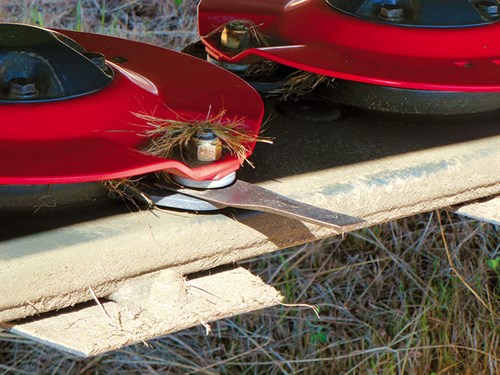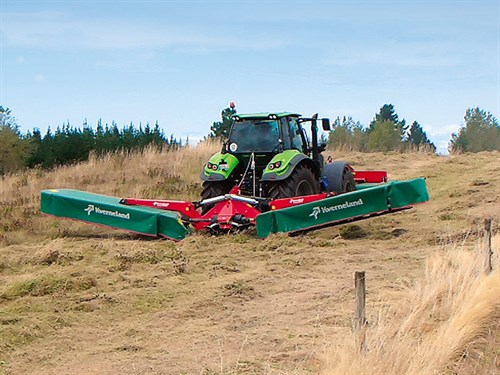Review: Kverneland Taarup 5095 M & 2832 F























|

|

|

|

|

|

|

|

|

|

|
At a field day early last year in Kinloch, near Taupo, hosted by Power Farming, I was given the chance to have a first-hand look at a Kverneland Taarup triple mower. Although the crops were fairly sparse, I remember thinking at the time they were lucky to have anything to mow at all.
The Kverneland Taarup set of triples uses the company's 5095 M rear butterfly unit. This features two 3.6-metre cutterbars. Combined with the 2823 F Front mounted mower, with a 3.2-metre bar, this gives a working width of up to 9.5 metres, depending on the overlap setup. That's a seriously impressive work rate, and I was pretty keen to check what it had to offer.
Naturally, being a Power Farming event, the mowers were hitched up to a Deutz-Fahr 7250 TTV. This is an impressive machine in its own right and with over 260hp, it was more than man enough to drive the mowers.
Cutterbar
Both front and rear units use the same reliable cutterbar from Kverneland. Built with two lengths of fully welded high quality C section steel, the result is an extremely tough bar and sealed housing which eliminates the possibility of oil leaks. The high oil capacity inside the bar also ensures gears are consistently running in oil, providing excellent lubrication and cooling.
Precision cut gears with long rounded teeth keep noise and vibration low, while minimising power losses across the cutter bar. Underneath the cutter bar, slim smooth stone guards under each disc improve the cutting performance, while allowing for relatively low cutting heights.
One of the first things you'll notice are the round discs on the mower, as opposed to the more common oval shaped discs. Kverneland claims that this limits damage when foreign objects are encountered, as they will be thrown clear, rather than jamming between the discs.
It seems a fairly logical claim to me. Potentially this design could limit the amount of overlap, although as the blades run low under the discs they are still timed with a large amount of overlap.
Blades
The blades themselves are common twisted double-sided blades, which are pretty standard on many machines. They are very economical and deliver a clean cut. I'm pretty sure anyone with more than a few acres of mowing under their belt will agree that quick change blades are a godsend, so I was pleased to find the system in place in this machine. The ProFit system uses a spacer with a locator bolted on the underside of the disc.
Under this a piece of high tensile spring holds the blade in place under the spacer. To change the blade, the provided tool slides in between the disc and the spring steel, pressing downward to open the holder and replace the blade. When obstacles are stuck, the spring is forced upwards against the disc to prevent the loss of the blade.

Kverneland Taarup 5095 M
In the centre of the rear mount unit is a solid folded steel headstock to carry the two mowers. Incorporated into the head stock is a non-stop break-away system for the mower on each side. This mechanical system prevents damage if an obstacle is stuck. The break-away is set on a spring tension latch and when triggered, the cutterbar moves back and upwards away from the obstacle to prevent damage. It then returns to the original mowing position under its own weight, without the operator ever needing to stop.
Heavy-duty arms extend out from either side of the headstock to carry the mowers. The fact they attach at a pivot point to the top of the cutter bar frame, approximately one-third of the way out, gives the machine plenty of scope for lateral contour following. Two holes on each arm provide options for the amount of overlap with the front mower, depending on the conditions and terrain where they are being used, reducing the need for side-shift.
An easily adjusted mechanical central suspension system carries the weight of the cutter bars and ensures they follow the contours of the ground for a clean even cut, using two large springs on each side. Kverneland claims the system reacts to changing contours faster than a hydraulic system. I myself am still a little sceptical, although it performed reasonably well over the undulating ground on the day.
Heavy-duty hydraulic rams not only lift the mower clear of the grass when turning on the headland, but also raise the arms and fold the mower into the transport position. The fact they fold 110 degrees keeps the transport width under three metres and the weight distributed evenly. The end guards on either side also fold up to keep the overall transport height under four metres.
Drive for the mowers comes from the tractor and is split through a central gearbox on the headstock, then transferred through further driveshafts to gearboxes on each of the cutterbars. An overrun clutch is a welcome inclusion to prevent damage to the tractor.
Kverneland Taarup 2832 F
Decent front mowers are a tough ask for designers. The fact that they are being pushed along out in front of the tractor usually requires some clever engineering incorporated into the design, to make them perform effectively. The team at Kverneland has managed just this.
From the front of the central headstock, two curved arms extend back towards the tractor and down, to attach low on the frame of the cutter bar. Effectively this means the cutter bar is being pulled along by the headstock, which is being pushed out in front of the mower. What impressed me was the fact the headstock has been kept compact to prevent it from hindering operator visibility.

The front linkage stays in the same fixed position at all times and a hydraulic ram is used to raise and lower the mower on headlands and for transport. The headstock weight is carried by the front linkage. Adjustable springs remove some of the cutter bar weight, allowing it to float over the ground.
The mower moves completely independently of the front linkage. This setup not only allows 430mm of upwards and 210mm of downwards travel, but also 17 degrees of side-to-side lateral float, to tackle the toughest terrain. An A-frame hitch for the tractors front linkage makes hitching and unhitching a breeze and a break-away set-up helps minimise damage if an obstacle is struck.
Drive comes through a power shaft to a central gear box on the headstock of the mower, and from there to the left-hand side of the mower via a V belt and pulley set-up – an interesting choice. The good points to this set-up are that it allows the operating speed of the mower to be changed between 750 and 1000rpm, simply by changing the pulley wheels to lower fuel consumption.
The downside, and the reason most manufacturers are moving to direct drivelines, is the power loss associated with V belts, along with increased maintenance and wear.
The verdict
There are no two ways about it; the Kverneland triple mowers hitched up to the big Deutz-Fahr was an impressive set-up to look at, and I was equally impressed with the mowers in action. Although crops were somewhat sparse, it was good to see them operating on fairly undulating ground, which is often found around much of New Zealand.
The mowers are well built and have an air of simplicity about them, and the mechanical central suspension on the rear units is a great example of this. While I was not convinced that it is any better than a hydraulic system, it is much simpler and still very effective.
The design of the front mower also impressed, with plenty of room to move for the cutterbar, ensuring exceptional ground following while maintaining visibility out in front for the operator.
The massive 9.5-metre maximum working width, along with the compact transport width of three metres, will appeal to those with a serious amount of ground to cover.
For the latest farm machinery reviews, subscribe to Farm Trader magazine here.
Keep up to date in the industry by signing up to Farm Trader's free newsletter or liking us on Facebook





